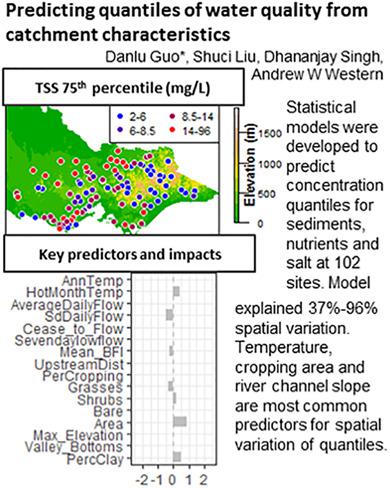当前位置:
X-MOL 学术
›
Hydrol. Process.
›
论文详情
Our official English website, www.x-mol.net, welcomes your
feedback! (Note: you will need to create a separate account there.)
Predicting quantiles of water quality from catchment characteristics
Hydrological Processes ( IF 2.8 ) Pub Date : 2020-11-28 , DOI: 10.1002/hyp.13996 Danlu Guo 1 , Shuci Liu 1 , Dhananjay Singh 1, 2 , Andrew W. Western 1
Hydrological Processes ( IF 2.8 ) Pub Date : 2020-11-28 , DOI: 10.1002/hyp.13996 Danlu Guo 1 , Shuci Liu 1 , Dhananjay Singh 1, 2 , Andrew W. Western 1
Affiliation

|
Water quality is often highly variable both in space and time, which poses challenges for modelling the more extreme concentrations. This study developed an alternative approach to predicting water quality quantiles at individual locations. We focused on river water quality data that were collected over 25 years, at 102 catchments across the State of Victoria, Australia. We analysed and modelled spatial patterns of the 10th, 25th, 50th, 75th and 90th percentiles of the concentrations of sediments, nutrients and salt, with six common constituents: total suspended solids (TSS), total phosphorus (TP), filterable reactive phosphorus (FRP), total Kjeldahl nitrogen (TKN), nitrate‐nitrite (NOx), and electrical conductivity (EC). To predict the spatial variation of each quantile for each constituent, we developed statistical regression models and exhaustively searched through 50 catchment characteristics to identify the best set of predictors for that quantile. The models predict the spatial variation in individual quantiles of TSS, TKN and EC well (66%–96% spatial variation explained), while those for TP, FRP and NOx have lower performance (37%–73% spatial variation explained). The most common factors that influence the spatial variations of the different constituents and quantiles are: annual temperature, percentage of cropping land area in catchment and channel slope. The statistical models developed can be used to predict how low‐ and high‐concentration quantiles change with landscape characteristics, and thus provide a useful tool for catchment managers to inform planning and policy making with changing climate and land use conditions.
中文翻译:

从流域特征预测水质的分位数
水质在时空上经常变化很大,这给建模更极端的浓度提出了挑战。这项研究开发了一种替代方法来预测各个位置的水质分位数。我们重点研究了25年来在澳大利亚维多利亚州102个流域收集的河流水质数据。我们对沉积物,养分和盐分浓度的第10、25、50、75和90%百分位进行了分析和建模,具有六个常见成分:总悬浮固体(TSS),总磷(TP),可过滤活性磷( FRP),凯氏氮(TKN),硝酸亚硝酸盐(NO x)和电导率(EC)。为了预测每个组成部分的每个分位数的空间变化,我们开发了统计回归模型,并详尽搜索了50个集水区特征,以确定该分位数的最佳预测变量集。这些模型预测了TSS,TKN和EC井各个分位数的空间变化(解释了66%–96%的空间变化),而TP,FRP和NO x具有较低的性能(解释了37%–73%的空间变化)。影响不同成分和分位数的空间变化的最常见因素是:年温度,集水区耕地面积的百分比和河道坡度。开发的统计模型可用于预测低浓度和高浓度分位数如何随景观特征变化,从而为集水区管理者提供有用的工具,使其可根据气候和土地使用条件的变化为规划和政策制定提供依据。
更新日期:2021-01-19
中文翻译:

从流域特征预测水质的分位数
水质在时空上经常变化很大,这给建模更极端的浓度提出了挑战。这项研究开发了一种替代方法来预测各个位置的水质分位数。我们重点研究了25年来在澳大利亚维多利亚州102个流域收集的河流水质数据。我们对沉积物,养分和盐分浓度的第10、25、50、75和90%百分位进行了分析和建模,具有六个常见成分:总悬浮固体(TSS),总磷(TP),可过滤活性磷( FRP),凯氏氮(TKN),硝酸亚硝酸盐(NO x)和电导率(EC)。为了预测每个组成部分的每个分位数的空间变化,我们开发了统计回归模型,并详尽搜索了50个集水区特征,以确定该分位数的最佳预测变量集。这些模型预测了TSS,TKN和EC井各个分位数的空间变化(解释了66%–96%的空间变化),而TP,FRP和NO x具有较低的性能(解释了37%–73%的空间变化)。影响不同成分和分位数的空间变化的最常见因素是:年温度,集水区耕地面积的百分比和河道坡度。开发的统计模型可用于预测低浓度和高浓度分位数如何随景观特征变化,从而为集水区管理者提供有用的工具,使其可根据气候和土地使用条件的变化为规划和政策制定提供依据。











































 京公网安备 11010802027423号
京公网安备 11010802027423号